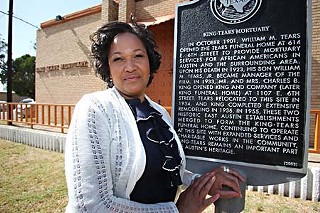What's Old Is Green Again
Eco-friendly, home-based funerals recall a bygone era
By Nora Ankrum, Fri., April 22, 2011
Mortician Janice King says her work is her calling, and on a mild evening in late March, that work called her to gently wash the face of Rescue Randy, a 160-pound dummy not unlike a giant Ken doll, as he solemnly lay in state in the garage of her East Austin home. King was hosting a gathering to demonstrate the services she provides through Solace Eco-Friendly Funeral Services, and Rescue Randy – donated by the Volente Fire Department – was the main attraction. Showing how a family might preside over a loved one during a similar at-home funeral, King – joined by her daughter and some helpers – wrapped Randy in a white cotton shroud, loaded him on a gurney, and rolled him to the hearse in her driveway. After depositing him inside the car, King's daughter commented that Randy surely weighs more than his 160 pounds. The crowd laughed.
Gathered in the driveway were various people who regularly work, in some way, with grief: hospice workers from Christopher House; Rebecca Bratton, whose homing doves King releases at ceremonies; Donna Belk and Sandy Booth, well-known for their pioneering work in the home funeral movement; and Janice's husband, Stuart King, whose 110-year-old family business, King-Tears Mortuary, was among Austin's first funeral homes. When it comes to burial traditions in the U.S., things haven't actually changed all that much since King-Tears opened shop in 1901 – until now.
In the U.S., traditional burial rituals are rooted in the Civil War, which popularized embalming as a way to keep slain soldiers' bodies viable on the journey home. The practice stuck, and today, the funeral industry annually buries tens of thousands of tons of steel and concrete inside which bodies lie well-preserved with embalming fluid. That fluid is most often made with formaldehyde, a carcinogenic chemical that poses health risks both indirectly, when it winds up in the soil, and directly, to morticians who regularly work with it. A typical family meanwhile spends $8,000 to $10,000 or more for a ritual that, 150 years ago, would actually have looked more like Rescue Randy's ceremony, with family and friends washing and dressing the body, then depositing it into the ground – perhaps in a shroud or wooden casket – where it would literally become a source of nutrition for the earth below.
King's work through Solace, a service provided via King-Tears, marks a return to the simpler – and more economical – rituals of the past. "You can have a very dignified and beautiful service without having to spend a lot of money," says King, whose philosophy combines two growing trends in the funeral industry – green burials and home funerals – with prices starting just above $2,000. King offers a simple, flexible template of services allowing families to be as hands-on (or -off) as they want to be, including the option to host viewings and memorial services at home for as many as three days, with professionals available to manage the paperwork, take care of the body as it lies in state, and help arrange details as needed, such as catering or even eco-friendly housecleaning.
While some aspects of the proceedings must be environmentally friendly, King offers various "shades of green," with the greenest burials involving no embalming at all, although eco-friendly embalming fluids are also available. Often, the body is laid to rest in a biodegradable casket (options include everything from cardboard to bamboo, banana leaf, or wicker; some families build their own caskets). An even simpler option, says King, is to wrap the body in a shroud. "I like to tell families they can use a favorite blanket that maybe their mother or grandmother made," she says.
The number of cemeteries available for completely eco-friendly burials is, admittedly, limited. But Georgetown's Our Lady of the Rosary has a section set aside for green burials, while southeast of town in Cedar Creek, Eloise Woods Community Natural Burial Park is devoted exclusively to burials free of "toxic chemicals or non-biodegradable materials." Basic plots there sell for just $900. Proprietor Ellen Macdonald bought the untamed land last June and says she is now "on a first-name basis with every tree, twig, and rock." Aside from some roads, walking trails, and stone benches installed by Macdonald herself, Eloise Woods is exactly that: woods. While grave markers are allowed, says Macdonald, they must fit her specifications, sitting low to the ground and made of natural fieldstone. "The idea is that no matter where you're standing in that wood, you can look around and you wouldn't even know there are people buried there," she says. "There's a deed restriction built in which specifies that this land will always be a green cemetery. ... All future owners will be bound by it, and I like that idea, because I feel as though I'm preserving a piece of open space."
While seven pets (including one cockatiel) have been laid to rest there, Eloise Woods did not become an officially dedicated cemetery until February, upon its first human burial – Eloise Woods' "first lady," as Janice King fondly calls her. King presided over the funeral less than a year after she first learned about green burials at a funeral convention. "You know how, when things are just right, it seems like the hair just stands up on your arm? I had this feeling," she says. "This is my ministry."
Got something to say on the subject? Send a letter to the editor.









